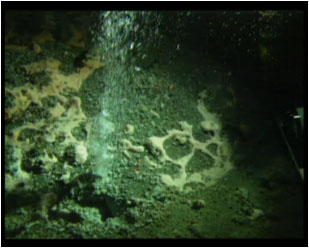 |
|
A fan of gas bubbles emanating from the seafloor
|
Fluid and gas emanations offshore Saudi Arabia (Red Sea) - a window to subseafloor hydrocarbon formation/ degradation processes
German coordinator: Dr. Mark Schmidt
Saudi coordinator: Dr. Radwan Al-Farawati
German scientists: Dr. Peter Linke, Dr. Daniel McGinnis, Prof. Lorenz Schwark
Saudi scientists: Dr. Alaa Al-Barakati and Dr. Mamdouh Jamal, Dr. Mohammed Orif
A near-seafloor fluid/gas sampling campaign will be carried out, based on existing organic and inorganic data from German/ Saudi Arabian research cruises that took place in the Red Sea between 1997 and 2005. The data were determined from water and sediment samples taken from seven brine-filled Red Sea Deeps (located at the rifting axis between 21 and 27°N).
The proposed sampling campaign is going to start along the “Jeddah Transect”, which connects the hot, hydrothermal Atlantis-II Deep area at the central rift axis with the continental slope and shallow shelf area near Jeddah. Oil/gas and fluid seeps located along the Jeddah Transect will be located by applying geophysical methods, ocean floor observation, and by using chemical in situ analytical methods. Sediment-seawater and brine-seawater fluid/gas fluxes will be determined. Land-based analyses (organic/ inorganic major compound determination, stable isotope analyses, biomarker analyses) will be performed in a close cooperation between IFM-GEOMAR/ Kiel University and KAU. Recovery of hydrocarbon prolific sediments from known deeps and fluid emanation sites discovered by this mapping campaign will also yield hydrothermal petroleum for sophisticated geochemical studies. Factors controlling the formation of hydrothermal petroleum, e.g. local heat flow regimes or catalytic influence of metal sulphides/oxides, will be investigated.
The project will give first insights into the hydrocarbon “kitchen” along the Jeddah Transect, which is expected to show a high regional variability. It will provide basic understanding of fluid/ gas formation/ migration at a continental margin related to young ocean rifting processes and halokinesis.
Scientific Goals
The Red Sea is generally regarded as the best area worldwide to study young rifting processes. It is also perfectly suitable as an analogue for the understanding of hydrocarbon generation and migration in deeply buried rift systems on continental margins like the North Sea and the Atlantic margins. The main Red Sea rift system developed in the Miocene and the presence of numerous oil and gas seeps in the Gulf of Suez, in the Red Sea, and the Gulf of Aden prove that mature hydrocarbon source rocks are available in these areas. Most of the source rocks are of Miocene age and consist of oil and gas prone syn-rift and post-rift shales from laterally limited depositional settings ranging from marine to lacustrine. They typically average 1 to 4% TOC (maximum 30%) with variable thicknesses. Miocene evaporites serve as seals. However, tectonic fracturing plays a major role in fluid/ gas transport and halokinesis formed different types of salt-related sub-seafloor trap structures and brine-filled depressions at the seafloor.
Various seafloor depressions are located along the rift axis and contain warm and dense (up to 26% NaCl) brine that is enriched in thermogenic hydrocarbons and CO2. The gases are accumulating with time as the release of fluid and gas into the water column is inhibited by strong physicochemical gradients between brine and seawater. This density structure is very unique, as the brine contains four main density-contributing components (Lake Kivu is the only other known system with a similar stratification). Salt and carbon dioxide increase the density, and temperature and methane reduce the density. This close competition leads to a so-called double-diffusive layering regime, which causes a staircase structure of well-mixed layers, separated by thin but very stable interfaces (like in the Atlantis-II Deep). However, gas bubble formation in - or passing through - the interface can (frequently) destroy the stable layering and potentially release gas plumes into the water column. Vertical dislocation of water containing near saturated gas levels may also lead to a plume formation.
The highest temperature (67°C) in Red Sea brine was measured in the Atlantis-II Deep located at about 21°N on the rifting axis. Locally high thermal heat flow in the northern Red Sea area (e.g. Shaban Deep at 26°N) is also observed and probably related to punctiform magmatic intrusions. First indications of variable hydrocarbon formation processes related to the locally highly variable (temperature) conditions along the rift axis are given by stable isotope data (δ13C, D/H) of methane and higher homologues from sediment and brine. E.g., elevated heat flow is assumed to have initiated early maturation of autochthonous organic matter, which may be accompanied by migrated bitumen, formed at greater depth. Substantial variability in the degree and extent of hydrothermal petroleum formation has been reported for the Kebrit, Shaban, and Atlantis-II deeps, however, the details of the mode of formation and its constraining factors have not been elucidated.
In summary, fluid/ gas migration across sediment-seawater and brine-seawater interfaces related to the subseafloor hydrocarbon pools, the higher heat flow to the south, syn- and post-rifting fracturing, and the halokinetic structuring will be studied in the Saudi Arabia Red Sea area. The distribution of gases and fluids into the water column will be studied using sophisticated in situ chemical and physical fine structure methods. This study is highly relevant with respect to today’s important questions concerning green house gas fluxes and emissions, as well as eutrophication and nutrient transports.
|